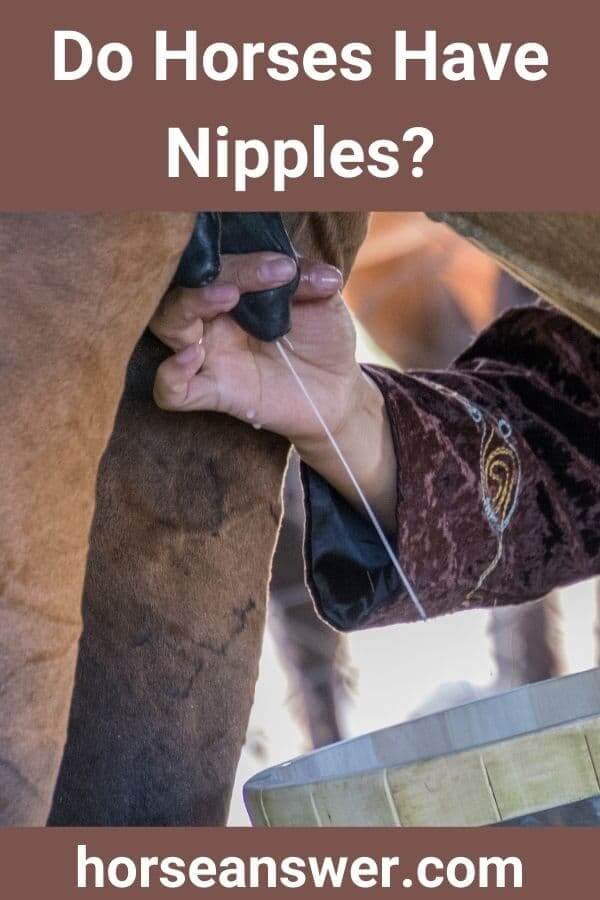Do Horses Have Nipples?
Me and my family were out tending to our horses the other day when suddenly my son asked me a question I wasn’t expecting.
He asked me if horses had nipples.
He’s at the age where he’s curious about virtually everything, so I wasn’t that surprised.
I was pretty sure they did, I told him, but I wasn’t entirely sure, so afterwards I decided to look into it and find out.
So, do horses have nipples?
Yes, both male and female horses have nipples. Male nipples are very rudimentary and can be difficult to make out but are certainly there. In any case, they serve no real function. For females, horses need to suckle like any other mammal, so nipples serve an essential function.
The simple answer is yes, then.
Horses have nipples, as indeed do virtually all mammals.
It’s essential to raising offspring.
Females typically have much more prominent nipples than males, but both males and females will always have them.
Let’s look further into this question.
How many nipples does a horse have?
In terms of functional nipples that a female would have—teats, in other words—horses only have two teats, nipples and mammary glands.
This is unlike, say, cows, which have four teats.
These are on the underside of the horse, towards the back, where the foal can most easily get at them after birth.
Male nipples are virtually impossible to see most of the time.
In fact, the only time you ever really stand a chance of seeing one is if you’re able to witness the castration of a colt—which is not something I’d be interested in!
Nonetheless, male horses do indeed have two nipples in the same rough area where a female’s teats are.
Normally, they are hidden by the genitals.
So, unlike some quadruped mammals with many nipples, horses only have the same amount that we do.
Male nipples are much less prominent in horses than they are in humans, and are virtually impossible to see most of the time—but they are there.
Are there horses without nipples, then?
Male or female?
Do all horses have nipples?
Biologically speaking, all horses should have nipples.
If a horse does not have nipples, that is likely down to some kind of defect, however little it affects the horse’s health.
This is much, much more common in males.
Sometimes, their nipples are so difficult to detect that there’s no real discernible difference if it did not have any at all.
In females, nipples are more or less universal, since they serve an essential function in reproduction.
Again, a lack of nipples in a female would indicate some kind of deficit or defect.
An important thing to note about nipples, as I will get into shortly, is that they develop in utero long before sex is settled on by the embryo.
So, nipples are effectively one of the most important building blocks of the animal.
They are more or less universal because the process of gestation considers them to be essential enough to create immediately.
Can you milk a horse?
You certainly can, yes.
Naturally, horses have not been bred over the millennia as milking animals, so they don’t produce a great deal of milk, or milk that tastes particularly good—but they can be milked!
The method is much the same as cows, except that horse nipples are broader and you will have to get a bit of a firmer grip on it.
They won’t produce as much, either, so you’ll have to spend a longer time milking them than you would an ordinary dairy animal, like a cow or a goat.
Ultimately, there isn’t much advantage to milking horses.
Like I said, the milk doesn’t taste as good as more readily available milk, and the job is harder.
Not to mention the fact that you’ll have to get the horse pregnant and then take its calf away from it in order to be able to get the milk for yourself.
Milking horses isn’t worth it, is our verdict!
Why do male horses have nipples?
So, there are a couple of reasons in general why male mammals have nipples, though not all males do.
Hamsters, for example, do not have nipples on the males.
Horses do, though, and this is partly for one reason.
As I said, in utero, even before sex is decided on by the embryo, nipples have begun to develop on the fetus.
So, whether it turns out to be a male or a female, it will have nipples.
As I said, nipples are one of the most essential organs to reproduction for mammals.
Developing them early gives the horse the best chance of having healthy teats, and it doesn’t cause any issues that males have nipples too.
So, this is what it essentially comes down to.
Nipples are pretty much standard in the kingdom of mammals, then.
They’re essential to feeding our offspring in their earliest stages, so pretty much all mammals have them.
In horses, both males and females have nipples, though males’ are much harder to see.
In any case, nipples serve the same essential function in horses as they do in any other mammal: feeding the young after birth.
Nipples are ubiquitous across sex because they develop in utero before sexual distinction, which is the main reason both males and females have them.
